Inexpensive pouches and other lightweight packing organizers offer simple solutions to how to pack small things in your travel bags. They’ll keep small things organized, secure, accessible, and protected from damage. I’m talking about stuff like charging cords, lip balm, eye mask, in-ear headphones, hand sanitizer, or a wet pair of socks. Sure, squeeze individual items inside shoes or toss them into a cavernous space to let them roam free in your bag, and you’ll drive yourself crazy trying to access them when needed. Or they’ll find a way to disappear.
Packing organizers add a little extra weight to a bag. Still, it’s usually minimal, and they earn their keep given the many advantages.
Table of Contents
- Advantages of using small packing organizers
- Getting organized
- How to pack small things in your travel bags
- 1. Zippered pouch for wired in-ear headphones for everyday use
- 2. Zippered fabric pouch for noise-cancelling headphones
- 3. Zippered fabric pouch for an external battery pack
- 4. Lightweight packing cube for a ‘comfort pack’
- 5. Drawstring stuff sack for electronic accessories
- 6. Zippered pouch for first-aid supplies
- 7. Zippered 3-1-1 bag for toiletries
- 8. Zippered see-through envelope
- 9. See-through pouch for miscellaneous travel aids
- 10. Reusable pouch for health aids
- 11. Small circular pill case
- 12. Zippered see-through in-purse pouch
- 13. Pocket phone wallet case
- 14. Pouch for bedside/under-pillow kit
- 15. One or more dry bags
Advantages of using small packing organizers
1. Carry what’s needed
Why carry what’s not needed? Separate stuff into what you take in your day bag and what stays back at your accommodation. Or determine what needs to go in your in-flight personal item and what will be placed in the overhead bin or checked luggage. Small packing organizers make it easier to separate and carry items requiring access.
2. Use distinguishable organizers
With small packing organizers in various colours, shapes, and sizes, it’s easy to find something by sight or touch. This can be handy in the dark or if the bag is in a difficult-to-reach location.
3. Faster access
At security screening checkpoints, it’s often easier for an agent to isolate an item warranting further investigation without unpacking everything around it. If the agent describes what s/he sees on the screen, as some do, you can point the agent towards the right packing organizer. If several items must be unpacked to reach the offending item, returning them to the bag is easier if they’re in their packing organizers and not scattered on the examining table.
4. Efficient access
Knowing what’s in each packing organizer and where it is in your bag makes it easy to put your hand on the right one.
5. Less chance of loss and damage
Take the item out; put the packing organizer back where it belongs. Reverse the process when it’s time to return the item to its organizer and your bag. Skip the seatback pocket for hygienic reasons and the possibility of leaving stuff behind. Being vigilant about returning an item to its home represents a formula for losing things less often. It also reduces those stressful ‘Oh-no moments’ when you think something has gone missing.
Things will last longer because they’re protected from dirt and damage.
6. Combine complementary items
Retrieving something small from an in-flight personal item or day bag is often easier if packed in a small pouch with complementary items.
The convenience of having items together can mean the difference between the ability to have access or not at all. For example, wired in-ear noise-cancelling headphones are effective if they can be connected to a device and their charge lasts for the duration of the flight. Therefore, a charging cord, earphone jack, and possibly a dual-ports dongle might be necessary accessories to pack with the headphones.
Getting organized
Here are some suggestions for getting started.
- Make a packing list, or gather what you intend to pack.
- Categorize items (e.g., device accessories, first-aid supplies, toiletries).
- Sub-categorize them by use (e.g., match the respective charging cord with the device you expect to use at the time; separate in-flight toiletries and cosmetics from everyday ones).
- There’s no need to carry plastic bags or invest hard-earned travel funds in expensive packing cubes and other types of organizers. Many purchases come in handy pouches or drawstring bags worth putting aside. Save small leakproof containers. Drop into a dollar store with a creative eye for possibilities. Collect zippered pouches during your travels to remind you of your adventures. The online marketplace Etsy is another excellent source of ready-made or made-to-order organizers. Aim for functional and light in a variety of sizes and colours. You might need one to be waterproof, another to be padded, or another of the see-through type. For security, it might be handy to have some with attachment points for tethering to anchor points in your bag or clothing.
- Designate specific places in your bag for each organizer. Pack more valuable items deep inside. Easy access for you means easy access for pickpockets.
How to pack small things in your travel bags
Are you looking for ideas? In the event it’s helpful, here’s the system I use on most trips.
1. Zippered pouch for wired in-ear headphones for everyday use
My wired in-ear headphones double as ear plugs and sleep aid. Included with the Bose SoundSport in-ear headphones is a Lightning-to-Jack adapter for use with an iPhone. They’re packed in the original lightweight SoundSport circular pouch with its handy carabiner attached to a packable crossbody purse. Talk about convenience, especially for an impromptu stop at a restaurant, coffee shop, or any occasion to pick up where I last listened to my current audiobook.
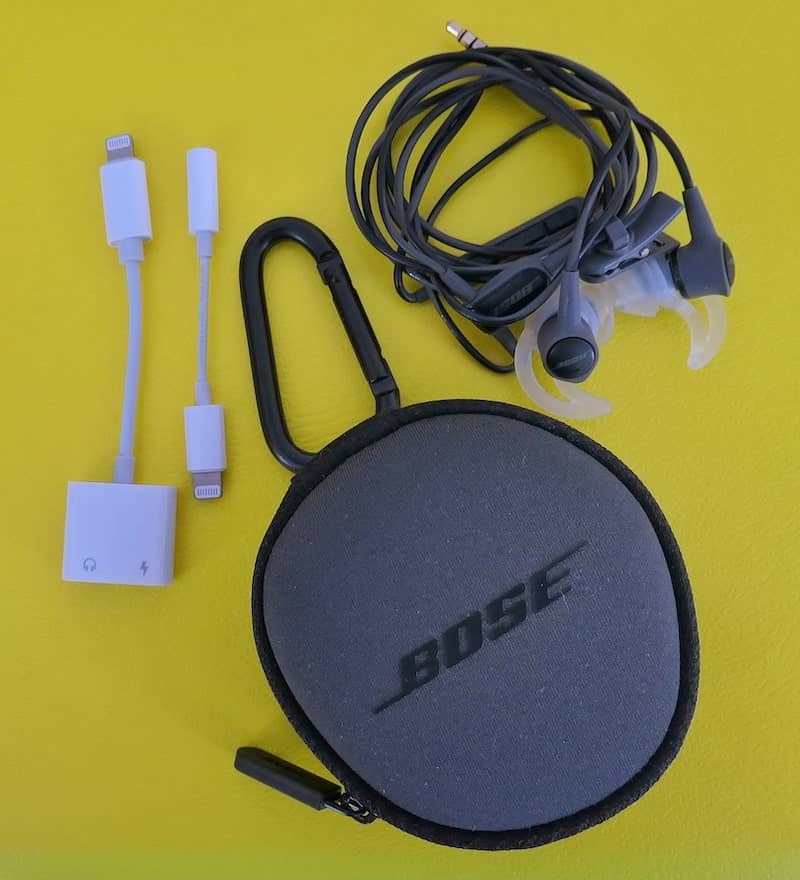
2. Zippered fabric pouch for noise-cancelling headphones
Noise-cancelling headphones are a game changer for flights, bus rides, train travel, and noisy environments. Included with my Bose QuietComfort 20 is its charging cord and a Lightning Dual Ports Dongle for a 3.5 mm Headphone Jack and Lightning Charger for use with an iPhone.
On a flight from Istanbul to Montreal, I was flying business class on points and made the mistake of relying on the over-head headphones provided by Turkish Airlines. This was a mistake, as they were extremely uncomfortable when dozing off. Now, the pouch containing my noise-cancelling in-ear headphones and associated accessories is packed in my in-flight personal item on every flight.
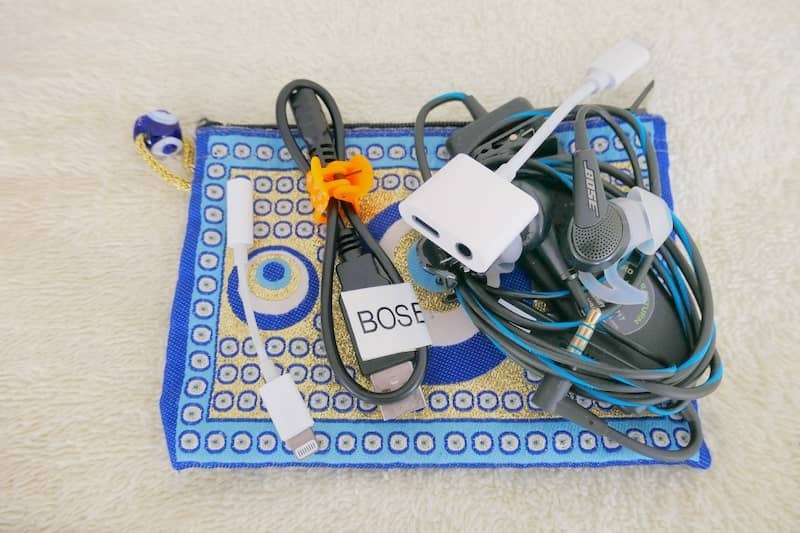
3. Zippered fabric pouch for an external battery pack
My external battery comes with a built-in charger to connect to a device. However, a short (0.5-metre) lightning charging cord is handy if I need to connect two lightning-compatible devices simultaneously. A tethering strap anchors the pouch to an attachment point in the bag.
Carrying the external battery pack pouch in my day bag is critical, especially if relying on my phone for navigation, accessing a transit pass, or using Apple Pay. Having a dead phone can be a huge inconvenience.

4. Lightweight packing cube for a ‘comfort pack’
A crossbody purse usually accommodates tissues, hand sanitizer, lip balm, compressed tablet towels, and soap leaves. When using a day pack or bicycle pannier, I find it more convenient to create a small ‘comfort pack’ for items that promote cleanliness and comfort. For a description, see Create a travel comfort pack for easy access to self-care essentials.

5. Drawstring stuff sack for electronic accessories
The Yarn Stuff Sack (small) from Tom Bihn is a durable workhorse made of ultra-tough and ultralight 200 dernier Halcyon/nylon ripstop fabric. I’ve had it for years. It contains chargers, adapters, a USB data blocker for charging devices at public USB ports, and related items.
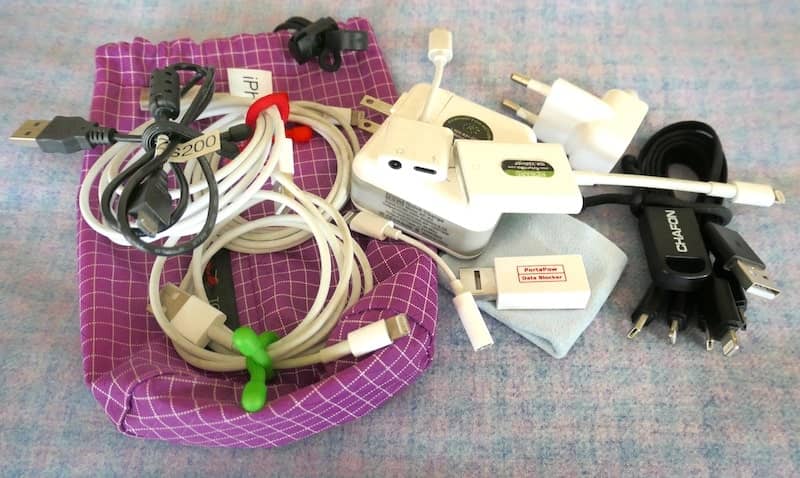
6. Zippered pouch for first-aid supplies
A friend has an Altoids tin for a small collection of supplies. I use The Ballistic Organizer Pouch (small), a soft-sided pouch from Tom Bihn. A first-aid kit should always be available. Mine is large enough to be stuffed with essentials, indispensable on more occasions than I can count.
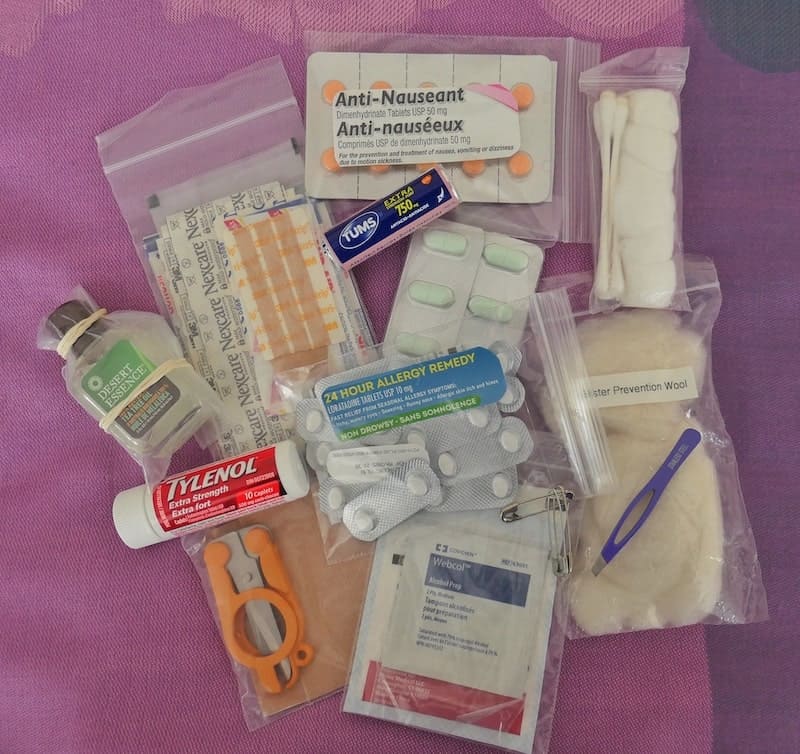
7. Zippered 3-1-1 bag for toiletries
At security checkpoints around the globe, zippered see-through reusable pouches have been accepted as a ‘3-1-1 bag’ for liquids packed in a carry-on luggage. My favourite is the Tom Bihn 3D organizer with a built-in hook. I’ve had it for many years.
I have two – one used as a 3-1-1- bag for liquids, gels, pastes, and powders and another for solid toiletries. Both have a double zipper and a hook that places them within easy reach at my accommodation. When I stay in women’s dorms in hostels where my request for a lower bunk has always been accommodated, both bags hang within easy reach from attachment points associated with the bunk above.
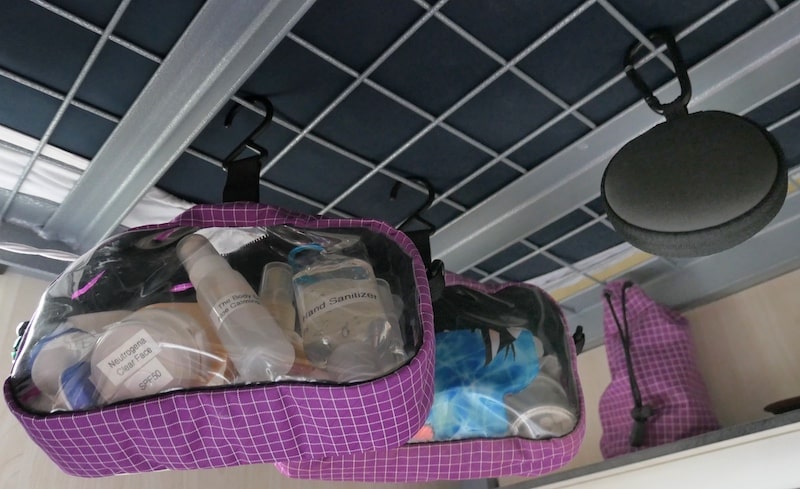
8. Zippered see-through envelope
A durable, zippered envelope is handy for an assortment of paper products. Travelon makes a set of 7 in various sizes, each with a handy attachment point.
Sometimes it’s convenient to carry printed travel bookings organized chronologically that can be discarded after use. It’s also useful to save receipts until they can be scanned, checked against bank statements, or added to an expense-sharing app like Splittr. Miscellaneous items such as information received with a local SIM card, the odd pamphlet, an unexpired transit pass, or a physician’s letter can be stored until needed.
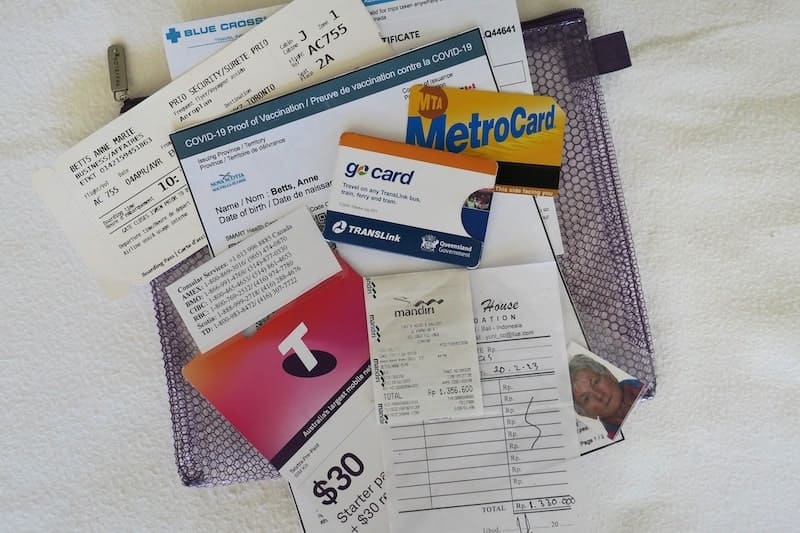
9. See-through pouch for miscellaneous travel aids
Standard items packed for every trip include a lock and cable, a braided travel clothesline, duct tape, denture tablets for cleaning a water bottle, and a couple of stretch straps with Velcro. These and other small miscellaneous items are easier to locate when packed in a reusable, see-through packing organizer.
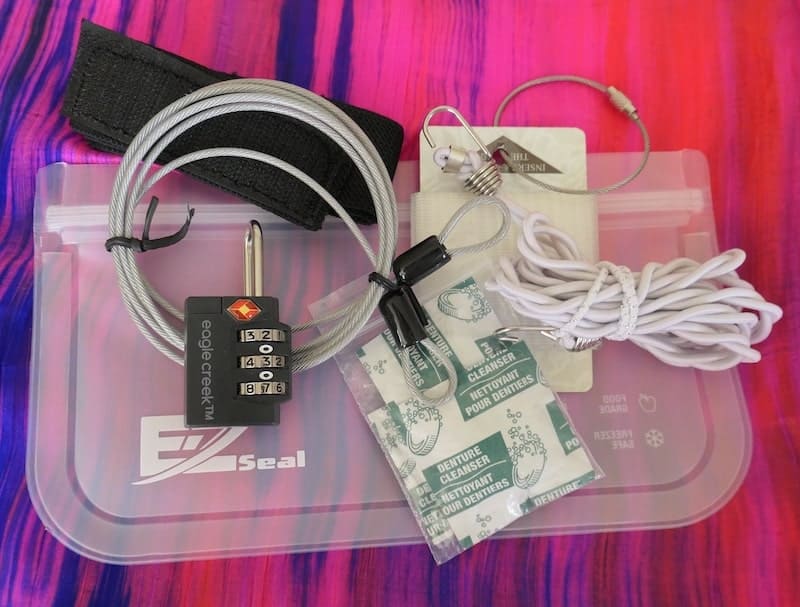
10. Reusable pouch for health aids
This dollar-store find is perfect for vitamins, probiotics, activated charcoal, medication, hydration support, immune-boost drink powders, and other health aids.
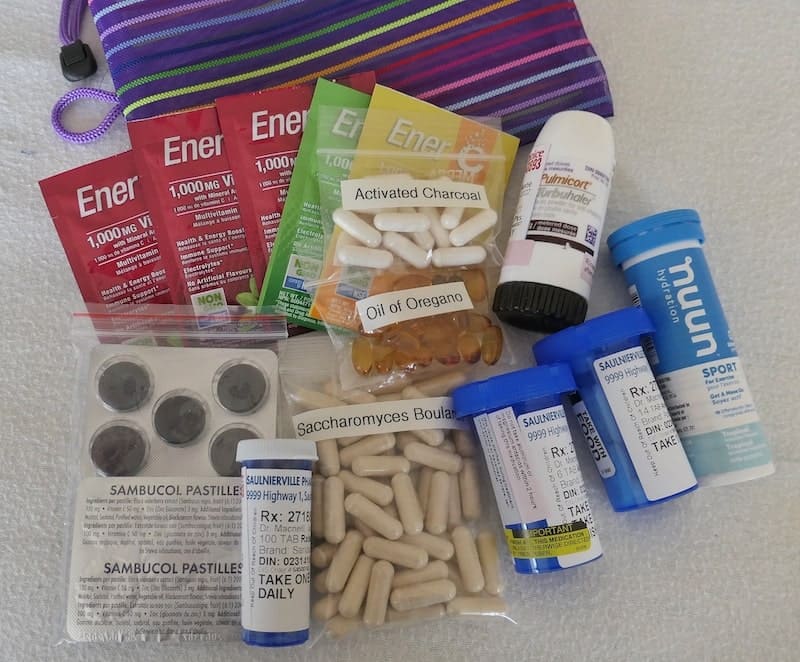
11. Small circular pill case
With a diameter of 4 cm / 1.6 in, a small circular pill case is small enough to slide into a travel purse or pocket for easy access to a three-day supply of medication, vitamins, and probiotics.
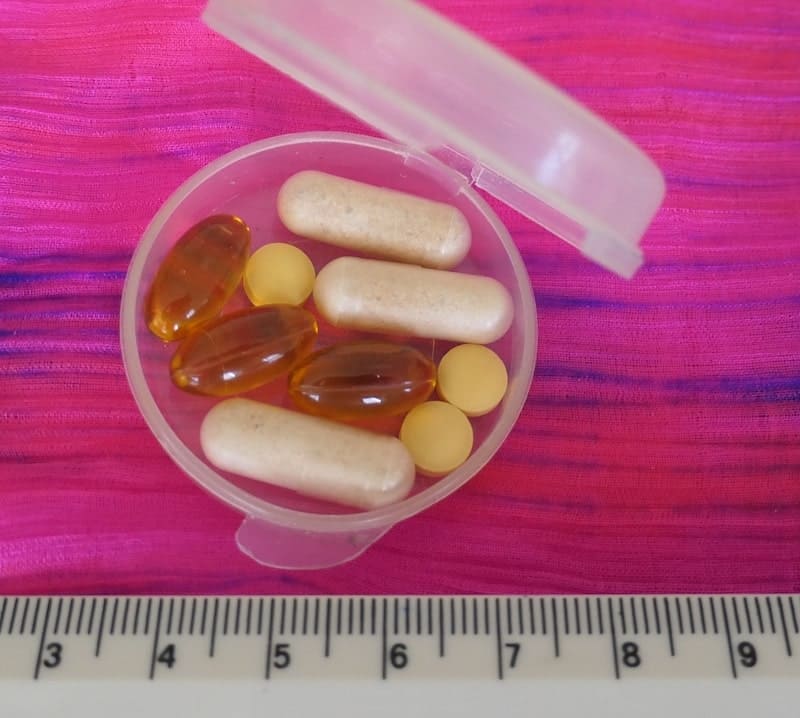
12. Zippered see-through in-purse pouch
The small zippered packing envelope from the Travelon Set of 7, when tethered to an attachment point in a crossbody travel purse, offers extra security for carrying cash. See-through folders cut from a page protector keep banknotes of different currencies separate and small zip-top craft bags help separate coins.
It’s also a great place to store an emergency contact card and a certificate for emergency medical insurance. I also carry a camera kit adapter for moving photos across to my tablet during a flight or with a bit of downtime while out and about. Moving, deleting, and editing photos while on the move means not ending up with duplicates and discards claiming valuable space on my devices and the cloud. Any strategy that allows for editing photos on the move represents a less onerous task (that might never be completed) when back home.
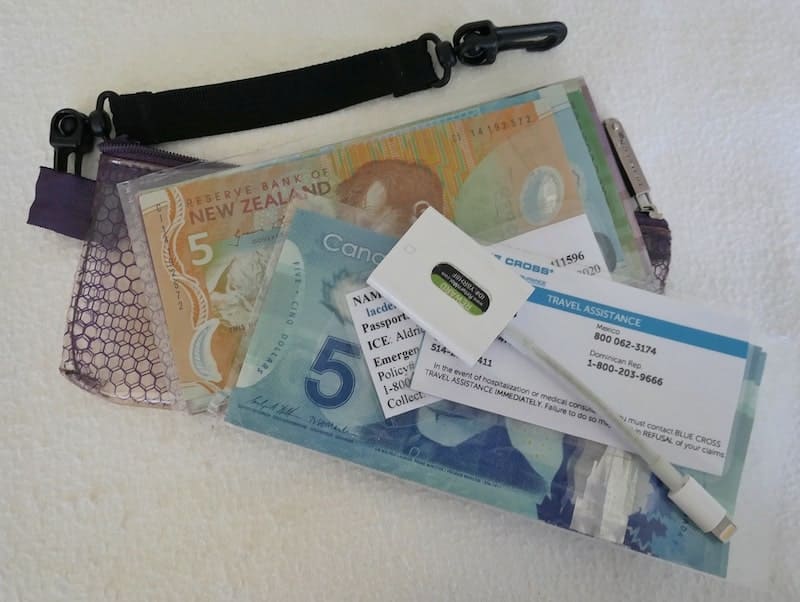
13. Pocket phone wallet case
A pocket phone case has two places for storing small things: the built-in pocket and the space between the cover and the phone. The latter is a perfect place to keep a SIM card case, an ejection tool, and emergency cash. The pocket stores my driver’s license, a financial card, and an emergency contact card.
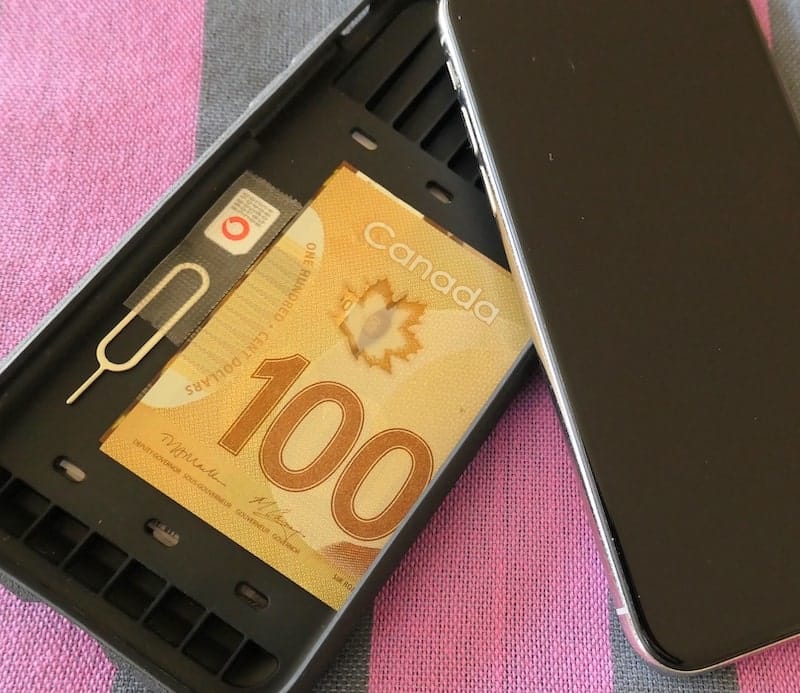
14. Pouch for bedside/under-pillow kit
A soft-sided pouch that can be placed on a bedside table or under a pillow can be useful for items needed during the night. Depending on accommodation and individual needs and preferences, these include an eye mask, earplugs, in-ear headphones, a small flashlight, and a handkerchief.
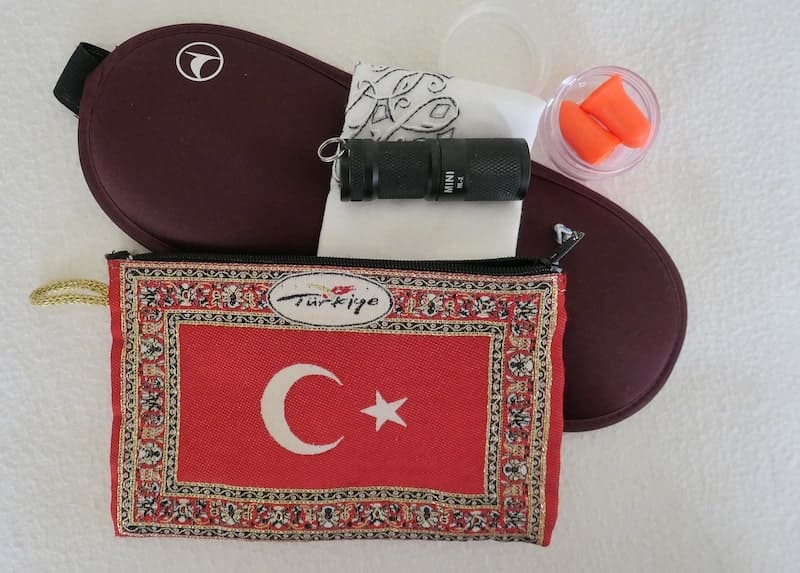
15. One or more dry bags
A dry bag means extra protection for electronics that can be damaged from spills, rainfall, or leaking toiletries.
They’re also handy for storing dirty laundry or damp items that failed to dry overnight. When packing a swimsuit, if it’s still damp on a travel day, a dry bag keeps moisture within the bag. I’ve also found a dry bag seals in the residual odours from a recent swim in a pool or the ocean.
Pack solid soap, shampoo, or conditioner bars in breathable, soft-sided cases. The Matador FlatPak Soap Bar Case is a perfect size for body soap. For smaller shampoo and conditioner bars, look for PUL (polyurethane laminate) pouches or ‘wet bags.’ Mine are from EcoAdorable at the online marketplace, Etsy.
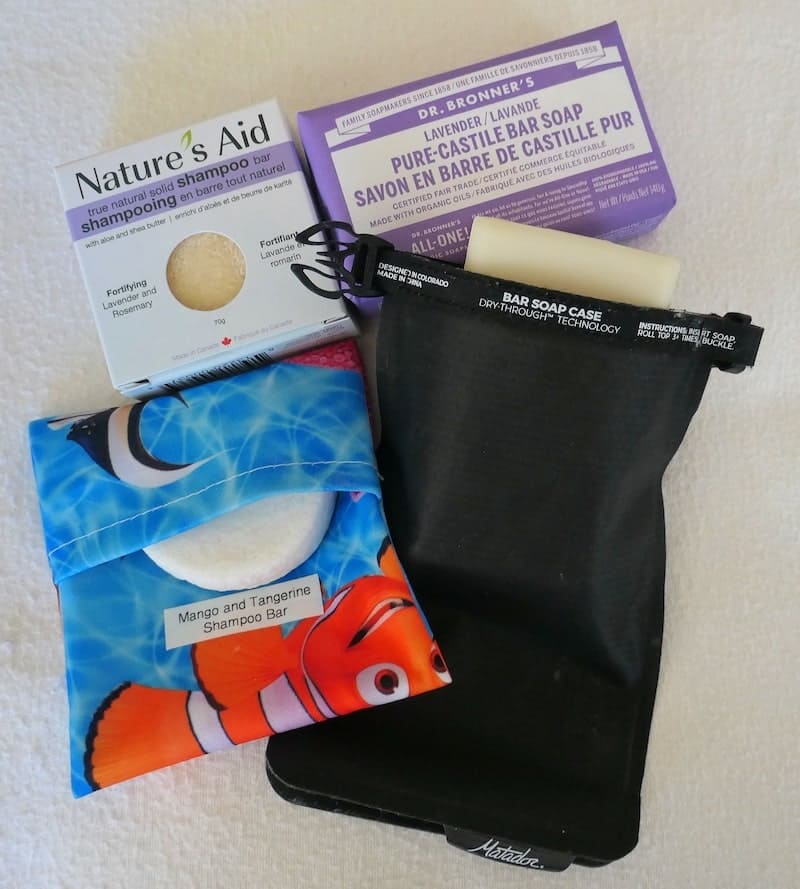
For more information on the many uses of dry bags, see 10 Reasons to travel with dry bags.
If you found this post helpful, please share it by selecting one or more social media buttons. You undoubtedly have a version of this strategy. Would you care to share what works for you in the comments? Thank you.
Might you be interested in related posts?
- Join the carry-on travel movement: pack light and tight with packing organizers
- 18 Tips on organizing a 3-1-1 bag for toiletries and cosmetics
- Create a travel comfort pack for easy access to self-care essentials
- Travel with tablet towels: a multipurpose essential every traveller should pack
- No soap? No problem travelling with soap leaves.
- For inspiration, shop Etsy for unique travel products
- 15 Tips on how to assemble a perfect travel first-aid kit
- 10 Reasons to travel with dry bags
- 12 Must-have features of an ideal phone wallet case for travel
- How to make a traveller’s emergency contact card in 5 easy steps
- Travelling with duct tape: 30 practical uses
- Pack light with a travel-friendly portable power bank
Care to pin for later?
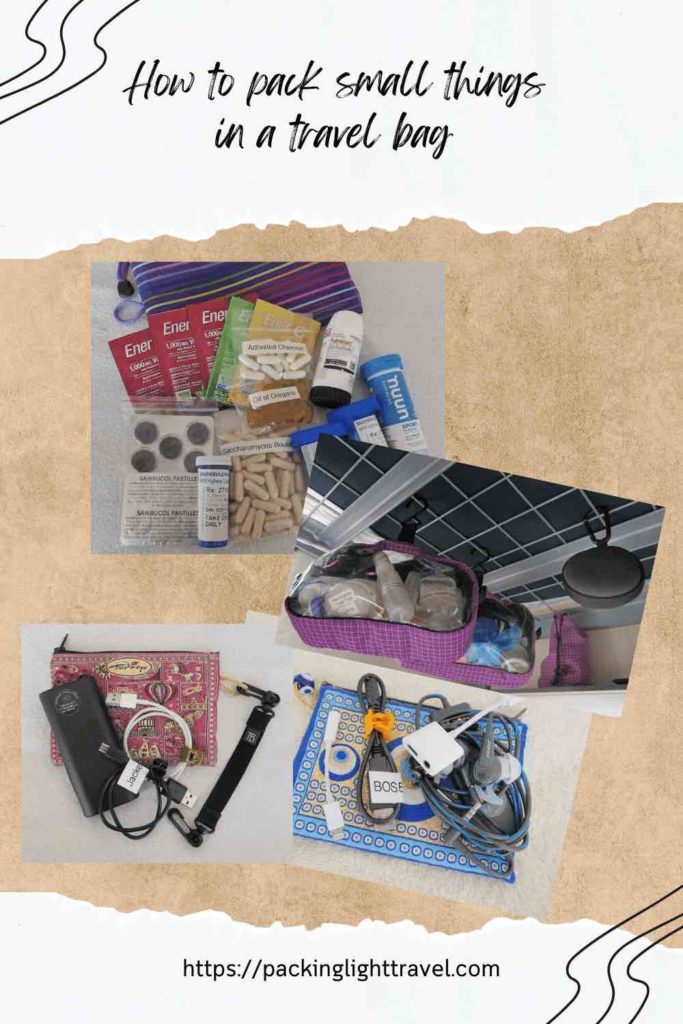
The Amazon links are affiliate links. If you click on one to purchase anything, you don’t pay more but this site earns a small commission that helps with the costs of operating Packing Light Travel. Thank you for your support.

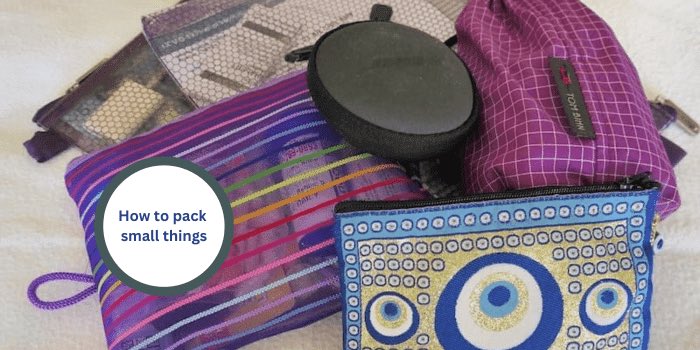




I am particularly impressed with the range of creative packing solutions you shared. From using pill containers for jewelry and using resealable bags for different items to employing cable organizers and packing cubes, your suggestions are incredibly helpful for keeping small essentials organized and easily accessible.